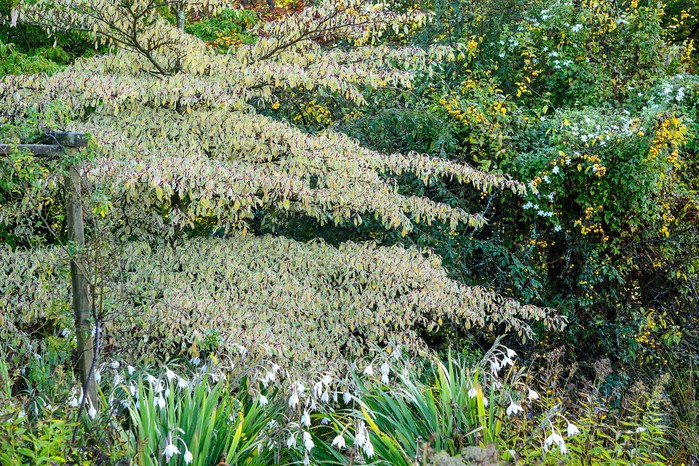
Acidanthera (Acidanthera murielae syn. Gladiolus murielae), also known as the Abyssinian gladiolus, callianthus, sword lily or peacock lily, is a graceful summer-flowering perennial. It has erect grass-like leaves and slender stems up to a metre tall, each one bearing several nodding funnel-shaped white flowers with purple throats. The flowers are attractive to a range of pollinators, including bees, which visit for nectar and pollen.
Acidanthera works well in cottage gardens and prairie-style planting designs, particularly when planted in drifts. It also makes a great addition to the cutting garden.
How to grow acidanthera
Grow acidanthera in a sheltered spot in full sun. For the best display, acidanthera needs fertile soil that is moist and well-drained, but it can also be planted in well-drained soil as it tolerates some drought. If you have a heavy, water retentive soil, grow acidanthera in rich, peat-free compost in large pots.
How long does it take for Acidanthera to grow and flower?
Acidanthera can be quite slow to appear after planting, first developing its root system underground, but once foliage appears, it grows very fast. It will produce its stunning flowers about three months after planting, in late summer or early autumn, and its foliage will look good until the first frosts.
Where to grow acidanthera
Acidanthera growing beneath a tree
Acidanthera makes a wonderful display when planted in drifts in a mixed border, or cottage garden. It also complements a ‘prairie-style’ planting of grasses and late-flowering perennials, and is a great addition to the cutting garden. If you grow it in a pot, position it in a place where you can get close enough appreciate the rich fragrance of its blooms.
How to plant acidanthera

Young acidanthera stems
Acidanthera grows from a bulb-like structure known as a corm, and many sellers refer to it as a bulb. While it’s not strictly necessary, soaking the corm in room-temperature water for a few hours before you plant it, can stimulate it into growth more quickly.
More like this
Acidanthera comes from East Africa and can tolerate temperatures down to -5ºC. However, to give them the best start it’s wise to wait to plant the corms outside in late spring when the soil has begun to warm up or, if you’re growing them in a pot, start them off indoors and move the pot outside when all danger of frost has past, usually from late May onwards.
If you plant the bulbs or corms at a depth of 15cm, the flower stems will not need staking as they grow. For impact, plant them in drifts, digging a hole 15cm deep and at least 50cm across, scattering 20 or so corms on the soil so that they are 10cm apart. Refill the hole and firm it down, and then give the whole area a good watering to settle the soil around the corms.
How to care for acidanthera
If you’re growing acidanthera in a pot, keep it well watered. Once the foliage appears, add liquid plant feed to the water every few weeks to encourage flowering. If growing it in the garden, use a soil conditioner such as home-made compost or composted manure to add organic matter, provide nutrients and encourage organisms that will create a healthy soil. Once planted, treat your acidanthera like any other herbaceous perennial. Deadhead after flowering to ensure the plant does not put any energy into producing seeds.
If you’re gardening in coastal and mild areas in the south of the UK, you can leave acidanthera in the ground over winter, allowing the foliage to die back and covering the area with a thick mulch to insulate the corms.
Otherwise, you have two options: dig up the corms, compost them and plant fresh corms the following year, or lift them, allow them to dry and store them in a dark, cool, frost-free place before planting them out again in late spring or early summer.
What if your acidanthera isn’t flowering? As already mentioned, acidanthera can make a slow start in cool or dry conditions, so be patient. If you’re treating your acidanthera as a perennial, either leaving it in the ground over winter or planting it again the following year, you may not get many flowers in its second season. This is because producing foliage and flowers uses up the energy stored in the corms and they may take a year’s break from flowering while they replenish their reserves.
To improve your chances of getting a second display of flowers feed the plants well while they’re growing, condition the soil annually (or replace it if growing your acidanthera in a pot) and use a liquid plant feed when the foliage appears.
How to prune acidanthera
Acidanthera does not require any pruning. Once the foliage is damaged by the first frosts, lift the corms, cut the foliage off and add it to your compost heap.
How to propagate acidanthera
During the growing season your acidanthera corms will produce smaller corms (known as cormlets). You can separate these when you lift the parent corms and store them for planting the following year. They’ll produce foliage for the next few seasons and are likely take a few years before they reach flowering size.
Pests and diseases
The new growth of acidanthera may be damaged by slugs. If the soil is too wet, the corms could be damaged by mould or gladiolus corm rot.
Advice on buying adidanthera
Acidanthera is sold under a several different names, including Acidanthera murielae, Acidanthera bicolor, Gladiolus callianthus ‘Murielae’, Gladiolus bicolor murielae. As with all bulb-like plants, the bigger the bulb or corm, the more nutrients and energy it will have stored up and the better it will flower. Choose the biggest you can, inspect them carefully and reject any with signs of pests, damage or disease (in particular, soft tissue or mould)
